Stab Bf 110s
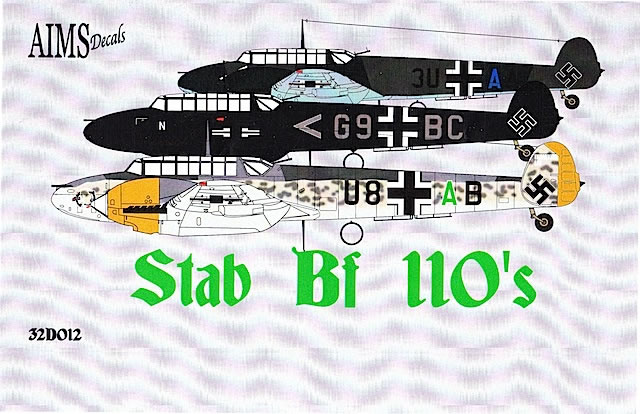
AIMS Decals, 1/32 scale
Catalogue Number and Description |
AIMS Decals
Item No. 32D012 - Stab Bf 110s
|
Scale |
1/32 |
Contents and Media: |
1 x decal sheet containing codes and individual aircraft markings for six Bf 110s, and enough Balkenkreuz for one aircraft; full set of cockpit instrument decals; 3 page A4 full colour instructions including port profiles of each aircraft, with scrap views as appropriate, RLM paint swatches, a detailed description of and reference listing for each aircraft, and a greyscale stencil placement guide.a |
Price: |
Available online from AIMS website and
from £9.99 (export) online from Hannants
|
Review Type: |
First Look |
Advantages: |
Interesting range of subject aircraft; comprehensive instructions; well produced decals with no obvious flaws. |
Disadvantages: |
No Hakenkruez included. |
Conclusion: |
This sheet provides markings for an interesting selection of early Daimler-Benz-powered Bf 110s. It has been produced to AIMS’ usual high standards and should be considered by anyone planning to build a 1/32 Dragon/Cyber-Hobby Bf 110 – highly recommended. |
Reviewed by Brad Fallen

HyperScale is proudly supported by Squadron.com
This recent release by John McIllmurray’s AIMS label focuses on Bf 110s flown by Luftwaffe Stab (Staff) personnel in the early years of World War 2. The six aircraft featured are all Bf 110 Cs or Es, for which the only available 1/32 kits are the well-regarded Dragon/Cyber-Hobby releases from several years ago.
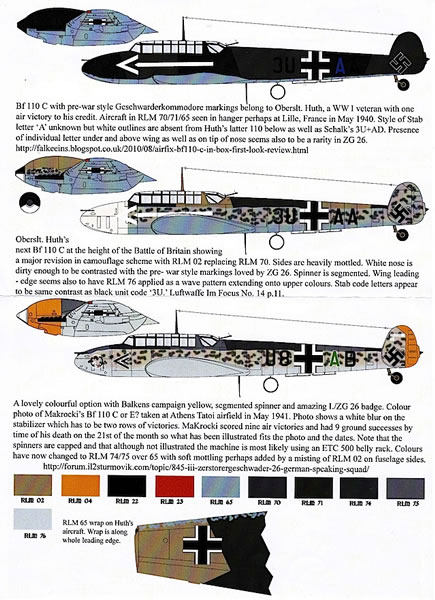
However AIMS is also producing this set in 1/48 and 1/72 (with an expanded range of subjects) where there are a wider variety of kits available – see Mark Davies’ review of the 1/72 scale set here.
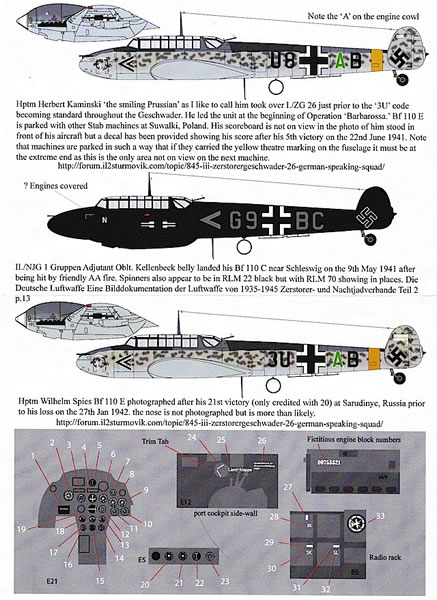
The aircraft are as follows:
- Bf 110 C '3U+AA', flown by Oberslt Huth of ZG 26, and perhaps based at Lille, France, in May 1940. Camouflage was RLM 70 Black Green and RLM 71 Dark Green splinter over RLM 65 Light Blue, with this subdued scheme enlivened by a (probably) RLM 24 Dark Blue Stab code letter 'A' and large white arrow on each side of the fuselage.
- Next is an identically coded, but different, BF 110 C flown by Huth during the Battle of Britain in 1940 (no specific date is provided). By this time the pre-war 70/71 camouflage had been replaced with RLM 02 Grey and RLM 71 splinter over RLM 65, with fuselage sides heavily mottled with what appear to be RLM 02 and RLM 71 over an RLM 65 base. The RLM 65 on the lower wings wraps around into a mottle on the upper leading edge of the wings. The nose is white, and as with the previous aircraft there are large white arrows on the fuselage sides.
- Bf 110 C or E, ‘U8+AB’, flown by Wilhelm Makrocki of I./ZG 26, Tatoi airfield, Athens, Greece, May 1941. This colourful machine was camouflaged in RLM 74 Grey Green and RLM 75 Grey Violet over RLM 76 Light Blue, with 74/75 and possibly 02 mottling on the fuselage sides. Rudders and engine cowls were RLM 04 Yellow.
- Also coded ‘U8+AB’, this Bf 110 E was flown by another commander of I./ZG 26, Herbert Kaminski, and photographed at Suwalki, Poland, in June 1941. It was camouflaged similarly to Makrocki’s aircraft, but without the RLM 04 cowls and rudders and possibly with an 04 fuselage band.
- Bf 110 C, ‘G9+BC’, flown by Oblt. Kellenbeck, Gruppen Adjutant of II./NJG 1 and which crash-landed near Schleswig, Germany on 9 May 1941. Overall RLM 22 Black.
- Bf 110 E, ‘3U+AB’, flown by Hptm. Wilhelm Spies of I./ZG 26 and photographed at Sarudinye, Russia, in possibly January 1942. ‘3U+AB’ wore camouflage almost identical to Kaminski’s machine.
AIMS’ painting and marking guide is printed on a double-sided A4 sheet with full-colour port view profiles of each aircraft, and scrap views as appropriate. There is a reasonably detailed description of each aircraft, with references listed for those wanting to conduct further research. The guide also has 10 RLM colour swatches and – in a nice touch – a comprehensive placement guide for the full set of cockpit instruments and placards that are included on the decal sheet.
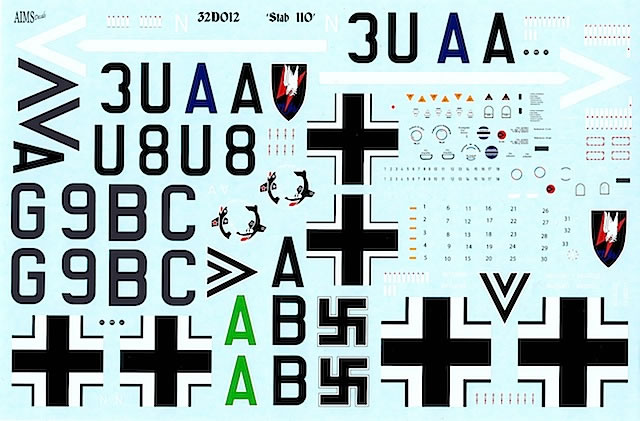
A greyscale stencil placement guide is printed on a separate A4 sheet. The guide includes an apology from Reverend McIllmurray for “forgetting to label stencils on [the] decal sheet, hopefully you can match what you see to this stencil diagram”. After comparing the diagram and the decal sheet, I agree that – with care – stencil placement should be a fairly straightforward exercise.
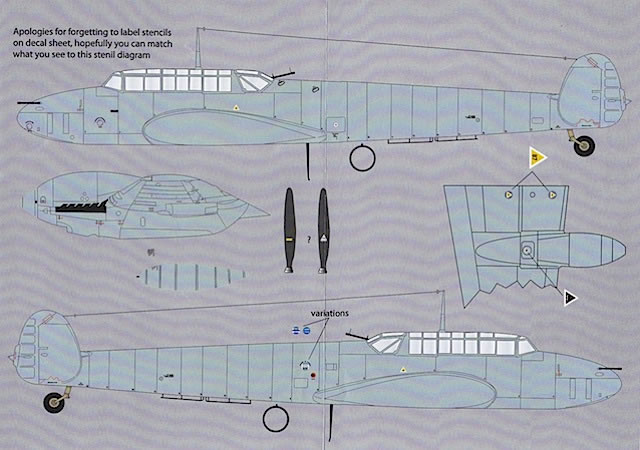
The decals themselves have been printed on a single sheet and to a high standard. All markings are crisply defined with no bleeding or misregistration. The unit insignia are particularly well done, and the stencils are legible. Some decals, such as code letters and the white arrows for Huth’s aircraft, have large areas of clear carrier film and will require either trimming or a generous underlying gloss coat to avoid silvering. Enough Balkenkreuz are provided to complete one aircraft, but no Hakenkruez are included.
This sheet provides markings for an interesting selection of early Daimler-Benz-powered Bf 110s. It has been produced to AIMS’ usual high standards and should be considered by anyone planning to build a 1/32 Dragon/Cyber-Hobby Bf 110 – highly recommended.
Thanks to AIMS for the samples
AIMS' decals, kits and accessories are
available online from AIMS website
Text and Images Copyright © 2015 by Brad Fallen
This Page Created on 17 March, 2015
Last updated
17 March, 2015
Back to
HyperScale Main Page |
